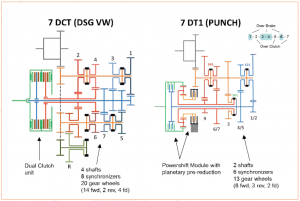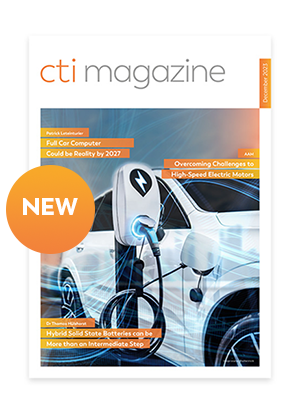
Electrification of powertrains is on the rise, in order to meet the environmental targets. This trend typically increases powertrain size, cost and complexity at the production line. A new approach emerges to tackle these challenges: a DCT, which is designed as 48V hybrid, with the conventional (non-hybrid) and high voltage strong hybrid being derivatives. Basing all 3 variants on one design allows adjustment of the fleet electrification mix with minimal effort.
An additional merit of the design is its compactness, as it takes up no more space than a conventional DCT. This was enabled by a new way of realizing the dual clutch principle. By linking a planetary gearset to one of the two clutches, a shiftable pre-reduction in front of transmission gearsets emerges. This allows to substantially reduce the amount of components and leaves space for an integrated e-machine.
1 Electric Vehicles (EVs) Need
While EVs need evolution time to mature, substantial reduction of CO2 emissions cannot wait [1]. Massive introduction of hybrids (mild, full and plug-in) is required to address this in a balanced way and allow both production and market to absorb the gradual on-cost.
The introduction of a flexible and integrated hybrid DCT platform, both available with 48V or high voltage e-motor is a logical choice for regions, already having a strong legacy in MT/DCT adoption (such as EU, China, India and South America). Cost-effectiveness can be achieved if the hybrid is not designed as a niche product, but as the new standard automatic that is able to be fitted in the OEM’s entire front-transverse platform program, regardless of the (continuously adjusting) mix in mild, full or plug-in hybrids.
2 Unique DCT Concept
2.1 Strongly Reduced Amount of Components
This DCT concept introduces a new way of realizing the dual clutch principle. By linking a planetary gearset to one of the two clutches, a shiftable pre-reduction in front of transmission gearsets emerges.
In this set-up, the new DCT called “DT2” (and also its predecessor DT1) makes each gearset in the gearbox available for 2 distinct transmission ratios; one when closing the normal clutch and the second by closing the static clutch (brake) of the planetary gearset. So, the 2 DCT “clutches” can connect to the same gearset by (pre-)synchronizing from one input shaft to the other. This is not seen in other in-market DCTs. Fig. 1

The clutch & topology innovation enables a significant reduction of internal gearwheels, shafts and synchro-sets. It results in a compact, efficient transmission leaving enough room for integration of the emachine (48V or HV). Fig. 1 illustrates how the new DCT principles are exploited for the 200Nm DT1, using only 13 gearwheels in total vs. 20 gearwheels in a mass produced benchmark 7DCT. Note that the DT1 topology constitutes a 7speed DCT with only 1 layshaft, which is also unique. The (higher torque) successor DT2, also has just 13 gear wheels in total.
However, the first DT2 release has (contrary to DT1) a very short 2nd layshaft carrying 2 gearwheels and a final drive pinion.
2.2 Seven Speeds for Optimal Gear Ratio
In theory, these principles imply that (for example) just 4 forward gearsets (8 gear wheels) inside the main gear cluster could enable a 8DCT, albeit with a number of gear dependencies and less flexible ratio design. Instead, we chose to create a unique 7DCT structure with less gear dependencies, leading to increased fuel efficiency and driver comfort.
2.3 Tailored Shifting
These valuable benefits, however, do come with a minor compromise. In case of the DT1 both 3rd and 4th gear are selected by engaging the braked planetary ratio. Therefore, to powershift from 3rd to 4th gear, the clutch is shortly sliding on 5th gear to provide shift time for synchronizer S01 (Fig. 1) towards 4th gear. Through sophisticated controls, this is unnoticeable for shifts at low to medium power. For shifting maximum engine torque some driveability specialists might slightly feel this “supported” 3/4 shift. For the application range of DT1 (120–200Nm) this overall drive quality is more than sufficient. In case of DT2 (230–350Nm) we configured the gear topology in such a way that only the 6/7 shift is slightly different from the other standard DCT shifts. In day-to-day driving this is unnoticed as 6/7 shifts usually occur at low power, when the driver reverts to a cruising mode at high vehicle speed. Nevertheless a full power kick-down shift from 7th to 5th gear is possible without compromise, particularly including electric machine boosting in case of the hybrid variants.
Author:
Dr Ir. Alex Serrarens, Manager Business Development, Punch Powertrain
Dr Ir. Roëll van Druten, Chief Engineer DCT, Punch Powertrain
MSc. PhD. Dirk Kok, System Engineer, Punch Powertrain
